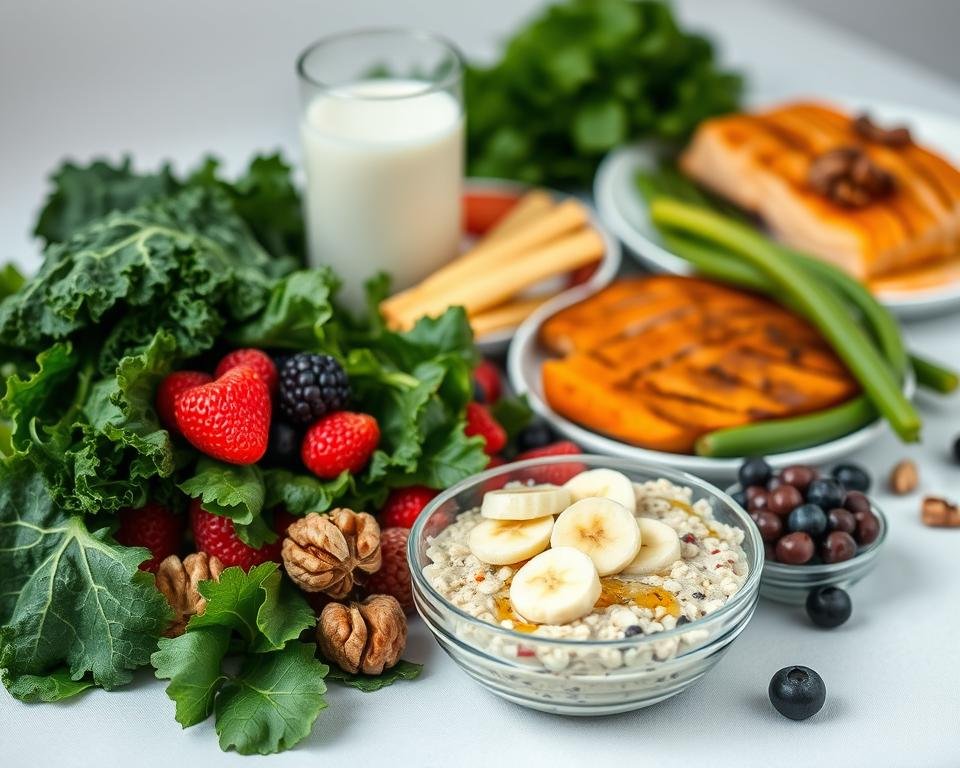“The food you eat can be either the safest and most powerful form of medicine or the slowest form of poison.” – Ann Wigmore’s wisdom rings especially true as we age. After 65, your plate becomes more than just meals – it’s your first line of defense against age-related challenges.
Your body undergoes significant changes that reshape dietary requirements. Metabolism slows by about 2-8% per decade after 30, meaning those extra cookies stick around longer. But here’s the twist: while calorie needs drop, demand for specific nutrients increases by up to 20% compared to younger adults.
This paradox creates unique challenges. Federal guidelines reveal most seniors fall short on calcium, vitamin D, and fiber. Yet overdo calories, and you risk weight-related issues. The solution? Nutrient-dense foods – ingredients packed with vitamins per bite like leafy greens, fatty fish, and legumes.
Key Takeaways
- Your metabolism slows naturally, requiring smarter food choices
- Essential nutrients like calcium and protein become more critical with age
- Quality trumps quantity – every bite should deliver nutritional value
- Federal guidelines recommend specific daily targets for senior health
- Simple meal planning strategies can address common deficiencies
Later sections will decode exact vitamin targets and show how to transform grocery lists into age-defying tools. For now, remember this: Your golden years deserve a diet that shines just as bright.
Why Nutrition is Crucial in Later Life
What you put on your plate after 65 becomes your body’s best ally. Smart food choices act like armor against age-related health shifts while keeping energy levels steady. Let’s explore how thoughtful eating patterns support vitality and tackle common hurdles.

Power Up With Purposeful Eating
A balanced diet does more than fill your stomach—it fights chronic issues. Studies show meals rich in leafy greens and fish lower risks of heart disease by up to 30%. Including calcium-packed foods like yogurt strengthens bones, reducing fracture chances. Even small tweaks matter: swapping processed meats for grilled chicken cuts sodium while boosting protein.
Staying energized becomes easier with vitamin B12 from eggs or fortified cereals. These nutrients help maintain muscle mass and mental sharpness. One Harvard report found seniors eating colorful veggies daily had 20% better mobility over a decade.
Navigating Real-Life Roadblocks
Appetite changes and tiredness can derail good intentions. Medications might alter taste buds or cause dry mouth. If chopping veggies feels exhausting, try pre-cut frozen options. Smaller, frequent meals often work better than three large plates.
Social isolation? Share healthy senior meals with friends during weekly potlucks. For those managing high blood pressure, herbs replace salt without sacrificing flavor. Remember: hydration matters just as much as solid foods—aim for six glasses of water daily.
Understanding Nutritional Needs After 65
Your golden years bring shifts in how your body processes food and uses energy. While you might need fewer calories than in your 40s, your demand for quality nutrients actually increases. This balancing act requires smarter choices to fuel your active lifestyle while protecting long-term health.

Recognizing Age-Related Dietary Changes
After 65, muscle mass naturally declines by 3-8% per decade—a process called sarcopenia. This means your protein needs increase even as your appetite might decrease. Your body also absorbs fewer nutrients from food, making vitamin B12 and calcium particularly crucial.
Metabolism slows about 50-100 calories daily compared to younger adults. But skimping on meals isn’t the answer. Focus instead on “every bite earning its place”—like choosing salmon over sausage for omega-3s that support brain health.
Federal Guidelines and Daily Caloric Requirements
The USDA recommends 1,600-2,200 calories daily for seniors, depending on activity levels. Here’s what that looks like:
- 5 ounces lean protein (try eggs or lentils)
- 2 cups colorful vegetables (spinach, carrots)
- 3 servings whole grains (oats, quinoa)
Compared to 30-year-olds, those over 65 need 20% more vitamin D and 30% more B12. Simple swaps help—replace white bread with whole grain versions, or snack on almonds instead of chips. Small changes create big impacts over time.
Essential Vitamins and Minerals for Aging Bodies
Your nutrient priorities shift as you age – like upgrading your body’s maintenance crew. Four key players stand out for protecting bones, preserving strength, and keeping energy steady. Let’s break down what your plate needs most.
Vitamin D and Calcium: Your Skeletal Superheroes
Bones become more fragile with time, but 1,200 mg of calcium daily (per federal guidelines) helps maintain density. Pair it with 800 IU of vitamin D – they work like a lock and key for absorption. A National Institute on Aging study found seniors meeting these targets had 30% fewer fractures over five years.
Try these combos:
- Fortified almond milk in morning oatmeal
- Canned salmon with edible bones at lunch
- Steamed kale with sesame seeds at dinner
Protein and B12: The Energy Architects
Muscle loss accelerates after 60, but 20-30 grams of protein per meal can slow this decline. Vitamin B12 teams up with protein to fuel your cells – crucial since many older adults absorb 50% less B12 from food.
Smart sources include:
- Eggs (6 grams protein each)
- Greek yogurt (17 grams per cup)
- Grilled trout (22 grams per fillet)
“These nutrients form a protective network,” explains a recent nutrition journal. Together, they reduce osteoporosis risk by 40% and support heart health by managing blood pressure. Your grocery list just became your best preventative medicine.
How to Incorporate Nutrient-Dense Foods into Your Diet
Transforming your meals into nutrient powerhouses doesn’t require complicated recipes or rare ingredients. Start by thinking of your plate as a canvas: half should burst with color from vegetables, a quarter with lean proteins, and the rest with whole grains. This simple formula ensures every meal delivers maximum vitamins and minerals per bite.

Smart Meal Blueprints
Try these easy swaps to boost your daily nutrition:
- Breakfast: Veggie omelet with spinach and mushrooms (20g protein) instead of sugary cereal
- Lunch: Quinoa bowls with grilled chicken, black beans, and roasted veggies
- Snacks: Greek yogurt with berries or hummus with carrot sticks
For dinner, bake salmon with lemon and dill – it’s packed with omega-3s and cooks in 15 minutes. “Batch cooking saves both time and nutrients,” notes registered dietitian Maria Lopez. Prepare large batches of soups or stews using frozen vegetables and low-sodium broth for ready-to-eat meals all week.
Watch portion sizes by using smaller plates – research shows this simple trick reduces calorie intake by 22% while keeping you satisfied. When shopping, fill your cart with these staples:
- Canned tuna in water (quick protein source)
- Frozen mixed vegetables (retain more nutrients than some fresh options)
- Oatmeal (fiber-rich breakfast base)
Stay clear of hidden saturated fats by choosing olive oil over butter and baking instead of frying. Need dessert? Blend frozen bananas with cocoa powder for a creamy treat that satisfies sweet cravings without added sugar.
Overcoming Barriers to Healthy Eating
Eating well in later years isn’t just about what’s on your plate—it’s about overcoming hidden hurdles. Many older adults face challenges like shifting appetites or medications that alter taste, but simple adjustments can turn roadblocks into solutions.
Managing Appetite Changes and Medication Effects
When hunger cues fade, try eating 5-6 small meals instead of three large ones. Keep protein-rich snacks like hard-boiled eggs or nut butter handy. If medications leave a metallic taste, citrus marinades or fresh herbs can revive flavors.
Dry mouth from prescriptions? Sip herbal teas or broth-based soups between meals. For low-energy days, stock freezer-friendly meatless meals packed with beans and veggies. A Johns Hopkins study found seniors using these strategies consumed 40% more nutrients per day.
Social Engagement and Community Meal Options
Dining alone often leads to skipped meals. Join community center lunches or start a monthly potluck with neighbors. Many areas offer subsidized meal programs—like Seattle’s “Senior Food & Friends”—that deliver balanced dishes while fostering connections.
Local churches and rec centers often host free cooking classes tailored for older adults. “Sharing recipes with others gave me new ideas,” says 72-year-old Martha, who now swaps fish-based dishes with her walking group twice a week.
Lifestyle Strategies for Enhanced Wellbeing
Staying vibrant after 65 isn’t just about what you eat—it’s how you move and hydrate. Simple daily habits can boost digestion, maintain strength, and protect long-term health. Let’s explore two pillars of vitality that work hand-in-hand with your healthy meal planning strategies.
Movement: Your Digestive Ally
A brisk 15-minute walk after meals helps your body process food efficiently. Gentle exercises like chair yoga or swimming maintain muscle mass while reducing heart disease risk. Even light gardening counts—one study found seniors who garden weekly have 25% better nutrient absorption.
Try these easy routines:
- Morning stretches to wake up joints
- Afternoon resistance bands for strength
- Evening balance exercises like heel-to-toe walking
Water Wisdom Made Simple
Hydration affects everything from energy levels to joint comfort. Carry a marked water bottle—aim to finish it by lunch and refill. If plain water bores you, add cucumber slices or mint leaves. Foods like watermelon and soups also contribute to daily fluid goals.
Watch for subtle signs of dehydration:
- Dry mouth or mild dizziness
- Dark yellow urine
- Unusual fatigue between meals
Pair these habits with colorful vegetables and lean proteins for maximum impact. Local community centers often offer SilverSneakers classes—perfect for staying active while connecting with peers. Remember, small changes create lasting results when combined with smart diet choices.
Conclusion
Nourishing your body as you age is like fine-tuning a trusted instrument – small shifts create harmonious results. Prioritizing calcium-rich foods like leafy greens, vitamin D from fish, and lean protein sources helps maintain bone strength and energy levels. These choices directly support heart health and may lower risk factors for conditions like high blood pressure.
Simple strategies make big impacts. Build meals around colorful vegetables and whole grains while limiting processed meats. Federal guidelines suggest aiming for 5-ounce protein portions daily – try eggs or lentils for variety. Staying socially active through shared meals keeps both motivation and diet quality high.
Remember: progress beats perfection. Swap sugary drinks for herbal tea one day, or add an extra veggie to your plate. Consult your doctor about nutrition gaps – sometimes supplements fill specific needs. Your golden years deserve a health-forward approach that celebrates flavor and vitality in every bite.
